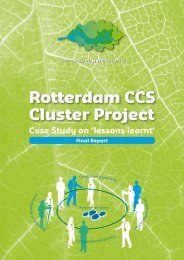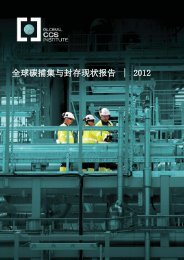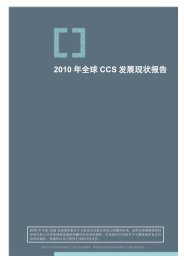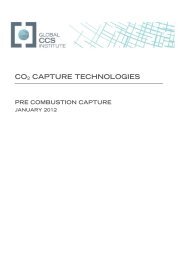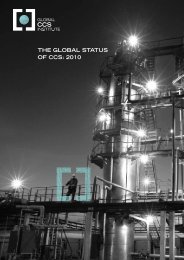Perceptions of CO2 Report - Global CCS Institute
Perceptions of CO2 Report - Global CCS Institute
Perceptions of CO2 Report - Global CCS Institute
- No tags were found...
You also want an ePaper? Increase the reach of your titles
YUMPU automatically turns print PDFs into web optimized ePapers that Google loves.
Respondents across all countries tended to agree that it is important to accept some risks relatedto a new technology, and that they were unwilling to pay more taxes to address climate change.8.2 How do people understand and perceive <strong>CCS</strong>?The current findings show that awareness <strong>of</strong> <strong>CCS</strong> was low amongst survey respondents, with overhalf (53%) indicating that they had not heard <strong>of</strong> the technology. These results are in accordancewith previous studies in Australia (Ashworth et al., 2009a), Japan (Itaoka et al,2009; Itaoka, Saito &Akai, 2005) and The Netherlands (de Best-Waldhober et al. 2009; de Coninck & Huijts, 2005)showing that the general public has low levels <strong>of</strong> knowledge about <strong>CCS</strong>. Awareness does seem tohave increased in recent years though, especially in the Netherlands, with 64% stating to have notheard about <strong>CCS</strong> in 2005, 43% in 2008 (de Best-Waldhober and Daamen, 2011) and 34% in thisstudy. This last result is similar to findings in a study done a few months earlier in the Netherlands,where 35% <strong>of</strong> respondents indicated that they had not heard <strong>of</strong> the technology (Paukovic et al,2011). This study provided a reasonable explanation for the recent rise in awareness in theNetherlands as well, with results showing that 95% <strong>of</strong> respondents that stated to have heard quitea bit about <strong>CCS</strong>, also indicated to have heard about the plans for implementation <strong>of</strong> a <strong>CCS</strong> projectin the town <strong>of</strong> Barendrecht. Combining this result with the fact that the Netherlands is the only <strong>of</strong>the three countries where there was such attention for the protest against a <strong>CCS</strong> demonstrationproject, it seems logical to conclude that the bigger increase in awareness observed in theNetherlands is caused by the attention for the <strong>CCS</strong> demonstration project in Barendrecht.One quarter <strong>of</strong> all respondents indicated they had heard <strong>of</strong> the technology but did not know what itwas, which highlights the gap between public awareness and actual knowledge <strong>of</strong> <strong>CCS</strong>.Respondents with higher awareness and self-reported knowledge <strong>of</strong> <strong>CCS</strong> had more pronouncedopinions about it, and tended to perceive it more positively as somewhat useful. In contrast, havingheard <strong>of</strong> <strong>CCS</strong> but having no knowledge <strong>of</strong> it did not lead to strong opinions. This is a similarfinding to that <strong>of</strong> existing risk communications research regarding opinions on unfamiliar topics, asdescribed by Ashworth and colleagues (2009). It may show that individuals with a less-formedopinion or less self-rated knowledge have the potential to be influenced, particularly by processes<strong>of</strong> engagement rather than by one-way provision <strong>of</strong> information (Ashworth et al., 2009a).Respondents held a number <strong>of</strong> misperceptions regarding the likelihood <strong>of</strong> <strong>CCS</strong> consequences andthe effects <strong>of</strong> CO 2 in <strong>CCS</strong>. In particular, respondents thought it likely that earthquakes would causeleakage <strong>of</strong> CO 2 , and believed CO 2 was stored in vacant underground chambers. After thetechnology was explained to respondents, <strong>CCS</strong> was generally perceived as positive, clean anduseful. However, many were uncertain about its safety and maturity. When awareness <strong>of</strong> <strong>CCS</strong> wascompared with perception <strong>of</strong> <strong>CCS</strong>, results showed that respondents had more established andstable views <strong>of</strong> <strong>CCS</strong> when they are better informed.8.2.1 WHAT INFLUENCES THESE <strong>CCS</strong> PERCEPTIONS?Several factors appeared to influence these initial impressions. One was the respondents’ statedwillingness to accept the risk that <strong>of</strong>ten accompanies new and emerging technologies; this had afavourable influence on perceptions <strong>of</strong> <strong>CCS</strong> as positive, safe, clean and useful. Concerns aboutthe risk <strong>of</strong> <strong>CCS</strong> on human health had the strongest negative impact on <strong>CCS</strong> impressions,demonstrating the importance <strong>of</strong> risk communications. Demographically, the older age ranges (50years and older) perceived <strong>CCS</strong> more favourably, and women perceived <strong>CCS</strong> less favourably.Impressions <strong>of</strong> <strong>CCS</strong> were negatively influenced by concerns over its health risks, while theperception that <strong>CCS</strong> is an effective climate change mitigation measure positively influenced overallimpressions <strong>of</strong> it. The percentage <strong>of</strong> the respondents who stated negative opinions seemed toUnderstanding how individuals perceive carbon dioxide | 43




